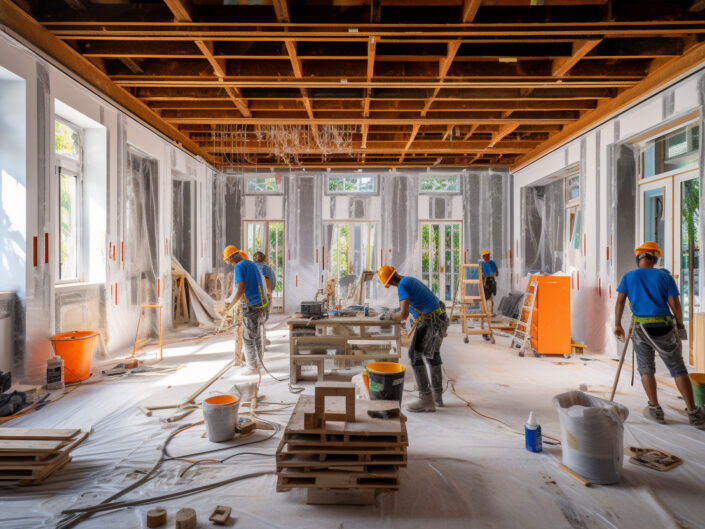These loans are designed to allow you to include the cost of improvements in one mortgage for either a purchase or refinance transaction.
FHA Streamline Rehabilitation Loans
There is an FHA loan program that is intended to allow a homebuyer to improve the home they live in or would like to buy without making costly repairs out of pocket or with high interest credit card debt. The loan is designed to allow you to easily purchase and include the cost of improvements in one mortgage.
Program Benefits
Up to $35,000 allowed for Repairs or Rehabilitation
Flexible FHA qualifying and credit guidelines
FHA Loan Limits Apply to 1-4 family owner occupied properties & approved condos
Eligible Improvements
• Repair/Replacement of roofs, gutters and downspouts
• Repair/Replacement/upgrade of existing HVAC systems
• Repair/Replacement/upgrade of plumbing and electrical systems
• Repair/Replacement of flooring
• Minor remodeling, such as kitchens, which does not involve structural repairs
• Painting, both exterior and interior
• Weatherization: storm windows and doors, insulation, weather stripping, etc.
• Purchase and installation of appliances, including freestanding ranges, refrigerators,
washers/dryers, dishwashers and microwave ovens
• Accessibility improvements for persons with disabilities
• Lead-based paint stabilization or abatement of lead-based paint hazards
• Repair/replace/add exterior decks, patios, porches patios, porches
• Basement finishing and remodeling, which does not involve structural repairs
• Basement waterproofing
• Window and door replacements and exterior wall re-siding
• Septic system and/or well repair or replacement
Ineligible Improvements
• Major rehabilitation or major remodeling, such as the relocation of a load-bearing wall
• New construction (including room additions)
• Repair of structural damage
• Repairs requiring detailed drawings or architectural exhibits
• Landscaping or similar site amenity improvements
• Any repair or improvement requiring a work schedule longer than six (6) months
• Rehabilitation activities that require more than two (2) payments per specialized contractor
Full FHA Rehabilitation Loans
Bigger projects can be accomplished using the full FHA Rehabilitation 203k program. Minimum repairs of $5000 are required and can involve room additions, moving of load bearing walls, etc. A HUD consultant is required when using this program.
Conventional Rehabilitation Loan – HomeStyle Renovation Loan
Allowable Improvements:
There are no required improvements or restrictions on the types of renovations allowed, nor is there a minimum dollar amount for renovations.
Generally, improvements should be permanently attached to the real property (either dwelling or land), with the exception of certain appliances installed with kitchen and utility room remodels. The borrower may use HomeStyle Renovation to purchase appliances as part of an overall remodeling project that includes substantial changes or upgrades to the rooms in which the appliances are placed.
HomeStyle Renovation may be used to complete the final work on a newly built home when the home is at least 90% complete. The remaining improvements must be related to completing non-structural items the original builder was unable to finish. Such work may include installation of buyer-selected items such as flooring, cabinets, kitchen appliances, fixtures, and trim.
HomeStyle Renovation may be used to construct various outdoor buildings and structures when allowed by local zoning regulations. These buildings or structures must be in compliance with any applicable building codes for the local area. Examples of acceptable structures include, but are not limited to, accessory units, garages, recreation rooms, and swimming pools.
HomeStyle Renovation may not be used for complete tear-down and reconstruction of the dwelling.
Renovation Costs:
Renovation costs consist of improvements plus the costs of associated fees. Renovation costs are limited to 75% of the “as completed” appraised value of the home.
· Labor and materials
· Property inspection fees
· Permits and licenses
· Mortgage Payment Reserves
· Contingency Reserve
· Title update fee ($200)
· Draw Inspection Fee: HUD Consultant will set the fee amount per draw inspection
(e.g. 5 draws x HUD Consultant fee of $200 per draw = $1000 total)
· HUD Consultant Work Write Up fee
· Architectural and engineering fees
· Other project related fees (e.g. home energy rating report, landscaping designer, geological study, mold inspection).
Establishing Value:
One full appraisal is required. A Property Inspection Waiver (PIW) is not allowed.
· The appraisal must provide an “as completed” value (subject to repairs/plans and specs).
· The appraisal must include a finalized copy of the plans, specs, contractor’s bid and project review if one is required.
· Any appraiser required or recommended repairs must be added to the plans and specs.
· Following completion of the renovation work, the borrower must obtain a certification of completion stating that the renovation was completed in accordance with the submitted plans and specs. The certification must be documented on the Appraisal Update and/or Completion Report (Form 1004D).
The purpose of a contingency reserve is to cover required unforeseen repairs that are discovered during the renovation. The contingency reserve is a required renovation cost and is typically financed in the loan amount (Financed Contingency). Alternately, the borrower may bring funds to closing to fund the contingency reserve; however, any assets required to fund the contingency must be documented and verified above the amount required for down payment and reserves (Borrower Funded Contingency).
· The contingency is calculated as a percent of the cost of labor, materials and soft costs.
· A minimum of a 10% and maximum of 20% contingency reserve is required. 15-20% is required if the utilities are off, the home has been without utilities for an extended period of time, is uninhabitable or if there is water, mold or fire damage.
· The contingency reserve may be released only if unforeseen required and necessary repairs or deficiencies are discovered during the renovation/construction.
· Any work paid from contingency funds must be approved by Plaza in advance, documented as completed and having improved real property.
· Unused Financed Contingency:
o Rate/Term Refinance: Up to the greater of 1% or $2,000 may be returned to the borrower on a rate/term refinance. Any rate/term funds exceeding the greater of 1% or $2,000 must be used to reduce the outstanding balance of the mortgage or see Additional Improvements below.
o Purchase: Funds must be used to reduce the outstanding balance of the mortgage or see Additional Improvements below
· Additional Improvements if contingency reserve funds remain at the completion of renovation:
o May be used for improvements or repairs that are permanently affixed to the real property.
o Funds may not be used to purchase personal property.
o All work described in the plans and specifications must have been completed.
· Unused Borrower Funded Contingency:
o Funds will be refunded to the borrowers once the renovation work has been completed and the certification of completion has been obtained.
Do It Yourself Option
The Do It Yourself option is available for renovations made to one-unit properties by the borrower. This option is not available for manufactured homes. Do It Yourself renovations may not represent more than 10% of the as completed value of the property. The lender must review and approve the renovations in advance, and must inspect the completion of all items that cost more than $5,000.
A borrower may request reimbursement for his or her payments for the cost of materials or for the cost of properly documented contract labor, but not for the cost of his or her sweat equity (labor). When a borrower chooses this option, the lender must fully budget for the cost of labor and materials related to the renovation so that, should the borrower be unable to complete the work, a contractor can be hired to finish any of the Do It Yourself repairs.


